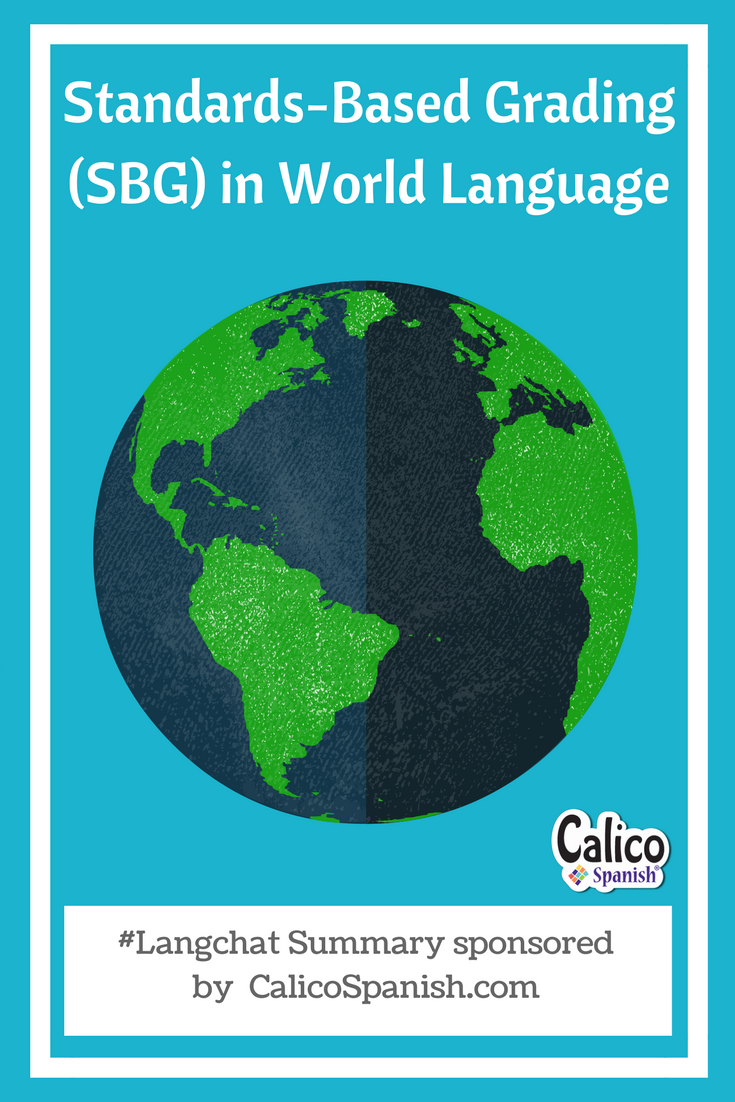Standards-Based Grading in a World Language Classroom
 Standards-Based Grading (SBG) has proven to be a helpful grading technique for #langchat teachers. Discussion on how SBG might be used in a world language classroom was the topic for last week’s #langchat.
Standards-Based Grading (SBG) has proven to be a helpful grading technique for #langchat teachers. Discussion on how SBG might be used in a world language classroom was the topic for last week’s #langchat.
– Follow the blog on Bloglovin –
Defining Standards-Based Grading
Last Thursday, #langchat opened with defining Standards-Based Grading (SBG) and determining how it can apply to measuring language proficiency. To begin, @dressurleben defined SBG as “using ACTFL [proficiency] levels as benchmarks for performance. [Students] must consistently perform at target level to meet standards.” In other words, SBG is, “establishing expectations and reporting/giving credit when students meet them” (@SraSpanglish). Many #langchat participants agreed on the idea that SBG “is grading based on performance, not compliance” (@MlleSulewski). @krisfauch said, “SBG is great [because] it clearly identifies strengths and weaknesses of [students].”
Many #langchat teachers believe that SBG is based on proficiency. @SECottrell said that “the standards the grading is based on are the proficiency standards” while, @doriecp finds “the communication goal area to be proficiency-based” as well.
Determining Scales for Measuring Standards
#Langchat teachers measure reading, listening, writing and speaking in a variety of ways through the SBG approach. @SrtaGlynn said, “We report on reading, writing, listening, speaking [because] that’s what is most clear to [students] and parents.” Choosing the appropriate scales in order to communicate proficiency levels can be tricky, but #langchat participants shared their ideas:
- @MlleSulewski said, “I have a different rubric for every mode of communication; my scale is based on proficiency guidelines/can-do statements.”
- @nathanlutz added, “In my [elementary] school, we have indicators & rate students according to their progress; more indicators [are] added as students move up.”
- @ jadelman75 uses “the target levels from @MartinaBex – advanced, proficient, developing, …”
– Like Calico Spanish on Facebook –
Translating SBG to Letter Grades
#Langchat teachers showed a frustration with giving letter grades based on a student’s language performance. @SraWilliams3 said:
I wish I didn’t give letter grades. Using rubric & letter grades seemed arbitrary.
One of the benefits of SBG is that it “is more descriptive than a letter grade – [it] tells exactly what a [student] can do” (@nathanlutz).
Determining Letter Grade Standards
- @welangley said, “even if we do adjust what each grade means, ‘a=exceeds expectations b=meets’, we will have push back because most will get B’s”
- @omahafrenchie said, “Personally, I’d like a C to be meeting the standard. But with the way society looks at grades, that would never fly.”
- @doriecp said, “I think the idea of C = average is looooong gone.”
- @SECottrell said, “When I gave letter grades, I did consider A as “excellent” i.e. exceeding the standard on what was standards-based.”
- @SrtaGlynn shared an idea and said, “Report on a 4 scale not a 100 point scale. 4=A, 3=B, 2=C, 1=D, 0=F.”
For a more detailed discussion on how to assign letter grades to proficiency-based grading scales and rubrics, @secottrell shared her own blog post on that topic, as well as the thoughts from the Creative Language Class.
– Follow Calico Spanish on Twitter –
Motivating Students to “Level Up”
It is important for students to have clear guidelines for what it takes to succeed in their language journey. #Langchat teachers encouraged communication with students about how they can demonstrate and achieve language growth and gave the following advice:
- @MlleSulewski said, “I think having clear rubric verbage helps in this area. Students can see what an A would be and adjust performance”
- @CatherineKU72: “Created a choice board with different levels of activities. [Students] could choose to stay at previous level (C) or demonstrate growth ^”
- @madamednmichael mentioned “giving differentiated assessments with above level, weighed choices allows students to show they exceed standard”
- SrtaGlynn said, “We account for trend in final semester grades, not average.”
How do we get students and parents to buy in to SBG?
Teachers have persuaded students and parents to buy into SBG through showing them “the value of how descriptive the SBG really is” (@nathanlutz). Through simple and clear explanation of the SBG approach, parents and administrators are able to gain understanding and show support. @doriecp said, “show them how it actually helps report what they CAN DO (or need to improve) rather than [giving] an arbitrary number/letter.” Communication is key to having community support. @madamednmichael added:
further, WE (teachers) have to be knowledgeable of our standards and confident explaining them.
– Follow us on Instagram too! –
Thank you
We would like to thank our lead moderator, Megan (@MlleSulewski), and her co-moderator Laura Sexton (@SraSpanglish) for guiding #langchat participants in our discussion on Standards-Based Grading. Thank you to those who shared their input and perspective on how this approach can practically be used within the classroom. Have a topic you’d like to chat about? Check out the #langchat wiki and suggest a topic!






No Comments